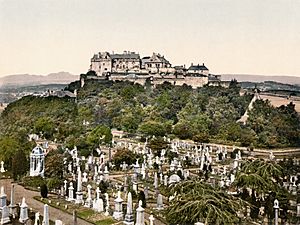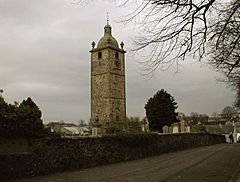Siege of Stirling Castle (1746) facts for kids
Quick facts for kids Siege of Stirling Castle |
|||||||
|---|---|---|---|---|---|---|---|
| Part of Jacobite rising of 1745 | |||||||
 Stirling Castle |
|||||||
|
|||||||
| Belligerents | |||||||
| Commanders and leaders | |||||||
| Strength | |||||||
| 8,000 - 9,000 | 700 | ||||||
The siege of Stirling Castle happened from January 8 to February 1, 1746. It was a key event during the Jacobite rising of 1745, a time when people tried to put the Stuart family back on the British throne. During the siege, a group called the Jacobites tried to capture Stirling Castle. The castle was defended by British government soldiers led by William Blakeney.
The Jacobites won a battle nearby at Falkirk Muir on January 17. This battle was against a British army trying to help the castle. However, the Jacobites still struggled to take Stirling Castle. When a larger British army, led by Duke of Cumberland, started moving north, the Jacobites gave up the siege. They left Stirling on February 1 and went to Inverness.
Contents
Why Stirling Castle Was Important

Stirling Castle was one of the strongest forts in Scotland. It was important because it controlled who could travel between the Highlands (the mountainous north) and the Lowlands (the flatter south).
In September 1745, the Jacobite army passed by the castle on their way to Edinburgh. But they didn't have enough time or the right tools to capture it then. The main Jacobite army later marched into England. They reached Derby in December before turning back. They entered Glasgow on December 26.
While in England, the Jacobites only managed to capture Carlisle. But marching into central England and returning safely was a big achievement for them.
French Help Arrives
In late November, a new leader named John Drummond arrived from France. He brought more weapons, money, and 150 trained soldiers. As a French army officer, he was told not to go into England until all British forts in Scotland were captured.
The Jacobites won another battle at Inverurie on December 23. This victory gave them control of northeast Scotland. By early January 1746, the Jacobites felt very strong and confident.
Their goal was now Stirling. Capturing it would give them a strong base and a safe port. This would be useful if they tried to invade England again. Stirling had two parts: the town and the castle. The town was easier to take, but the castle was much harder.
A Tough Challenge: Stirling Castle
Stirling Castle was naturally protected by cliffs. It also had strong, modern defenses. About 600 to 700 soldiers defended it, led by William Blakeney. He was an experienced soldier from Ireland. He was confident he could hold the castle.
The Jacobites had a big problem: they didn't have the right equipment to attack a strong castle. They had failed to take Edinburgh Castle earlier, even though they held the city for almost two months. They had captured Carlisle, but that was an old, weak fort defended by older soldiers. Stirling was much stronger and better defended. Many Jacobite leaders thought trying to take it was a waste of time.
The Siege Begins
The Jacobite cannons were led by Colonel James Grant. He was a Scottish officer serving in the French army. He had arrived in October with trained gunners. But their cannons were too small to damage the castle walls.
In November, a French engineer named Mirabel de Gordon arrived with heavier cannons. These included two large 18-pounder guns. De Gordon came to Stirling on January 6 to plan the attack. But his big cannons didn't arrive until January 14. In the end, they were never used in the battle. Many people thought De Gordon was not very good at his job.
Battle of Falkirk Muir
On January 17, a British army led by Henry Hawley tried to break the siege. This led to the Battle of Falkirk Muir. The battle started late in the afternoon in heavy snow. Both sides were confused. Most of Hawley's soldiers retreated to Edinburgh in good order. The Highlanders (Jacobite soldiers) stopped to take things from the British baggage wagons. This caused problems for the British, but they didn't see it as a major defeat.
Some people thought the Jacobites should have chased Hawley's army. This might have cut off Stirling and forced it to surrender. But most historians think it wouldn't have changed the final result. The battle caused arguments between Jacobite leaders. It also made the relationship worse between Prince Charles and his Scottish officers.
Problems with the Cannons
When the heavy cannons arrived on January 14, Colonel Grant wanted to put them near the town cemetery. From there, they would be almost level with the castle walls. But Prince Charles chose De Gordon's idea to put them on Gowan Hill. This spot was safer for the Jacobites. However, the ground there was rocky, so they had to build the gun positions using sacks of earth and wool. Moving these sacks was slow, hard, and dangerous. Also, the castle walls at this spot were above a very steep cliff, making it almost impossible to attack directly.

The Jacobite soldiers building these positions were hit daily by mortar fire from the castle. But Blakeney, the castle commander, reportedly didn't fire too much. He didn't want to stop them from working so hard on badly placed positions. By this time, some Jacobites thought De Gordon was either bad at his job or had been paid off by the enemy.
The Jacobites were also running low on supplies. De Gordon finally started firing on January 30, but only three of his six cannons were ready. Blakeney quickly fired back with very accurate shots. The Jacobite cannons were soon broken, and in less than half an hour, the gun position was abandoned. No one could go near it without being in great danger. One cannon was hit nine times, with some very deep marks.
The Siege Ends
On January 30, Charles learned that Cumberland's army was moving north from Edinburgh. Charles wanted to fight a big battle. But the clan chiefs told him that many of their Highlanders had gone home for the winter. They said the army was not ready to fight and advised retreating to Inverness. This would give them time to rest and get more soldiers.
Charles agreed, but this decision broke the last bit of trust between him and his Scottish officers. On February 1, 1746, the Jacobites gave up the siege and left Stirling.
What Happened Next
The Jacobites had been storing their gunpowder and weapons in the nearby church of St Ninians. As they retreated, the church blew up. Some people later said it was on purpose, but it was probably an accident from being careless with the supplies. Nine townspeople and some Jacobite soldiers died in the explosion.
Cumberland's army moved along the coast, getting supplies by sea. They reached Aberdeen on February 27. Both sides stopped fighting until the weather got better. By spring, the Jacobites were low on food, money, and weapons. When Cumberland left Aberdeen on April 8, Charles and his officers decided that fighting a battle was their best choice.
The Battle of Culloden on April 16 lasted less than an hour. It was a huge victory for the British government. About 1,500 Jacobite survivors gathered at Ruthven Barracks. But on April 20, Charles told them to go home. He said they needed French help to keep fighting and should wait until he returned with more support. He was picked up by a French ship on September 20 but never came back to Scotland.
Blakeney, the castle commander, was rewarded for his strong defense. He was promoted to Lieutenant-General and became the Lieutenant-Governor of Menorca, an island held by the British at the time. He was in charge when Menorca was captured by the French in June 1756.
Images for kids








